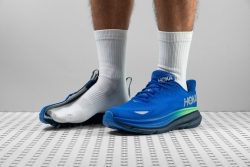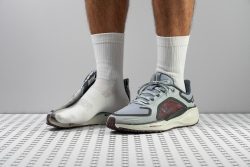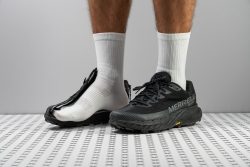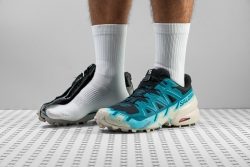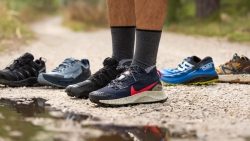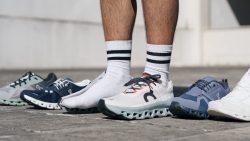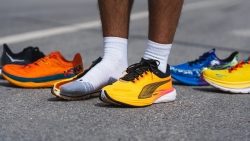5 Best Waterproof Running Shoes in 2025

We buy shoes ourselves. We earn commissions when you buy through us, at no extra cost. Why trust us
There are days when you have to deal with rain, puddles, slush and moisture; hence, the creation of waterproof running shoes. These shoes are made with a waterproof membrane, Gore-Tex being the most popular one, which keeps water out. And since there are waterproof versions of both trail and road running shoes, it might take some time to go through everything.
To help you narrow down your options, we have created this list to give you the finest shoes among all the waterproof models that we have reviewed. We are proud to say that each shoe went through our meticulous testing, both on the runs and in our lab.
Next to these top picks, we also write about different waterproof membranes, when not to wear waterproof running shoes, how to level up the waterproofness, and other details relevant for running in wet weather.
How we test waterproof running shoes
Before putting any waterproof shoe on this list, we always test it first in our shoe testing lab, and religiously follow these protocols:
- We buy each of the shoes we test with our own money to create bias-free reviews.
- We run with each pair to examine its fit, durability, and overall performance.
- To dig deeper, we cut shoes in half and then into pieces. Once cut in half, it's easy to see a Gore-Tex membrane as a double layer on the inside. It's usually grey and rather loose, and it is not glued to the upper.
- We test the shoe's durability, shock absorption, stiffness, and traction, and we thoroughly examine the upper, which is a priority in waterproof running shoes. By filling the shoe with smoke and watching where it comes out, we're able to see where the upper lets the air out and relate that to waterproofness. We also look at the upper under the microscope to examine it in greater detail.
Best waterproof running shoes overall
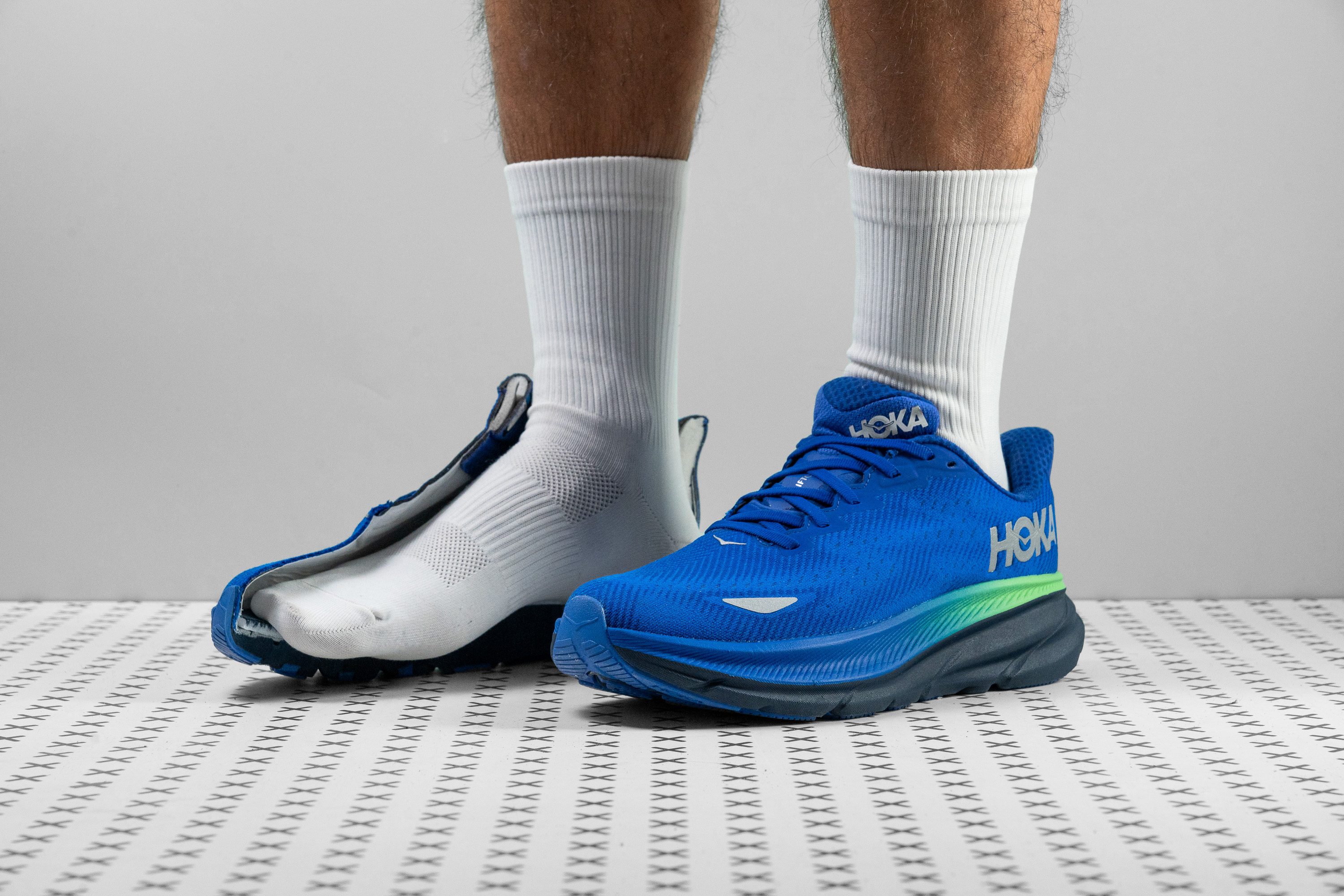



















































What makes it the best?
Our runs in wet conditions revealed the best waterproof running shoe, the Hoka Clifton 9 GTX. It’s a cushioned yet agile trainer that graced our streets and lab, all while wrapped up in a light package. It delivers the protection of a trail shoe without the bulky weight and lugs.
Our initial strides already tell us this Hoka has generous cushioning for any foot striker, and our calliper confirms an above-average 37.2/28.6 mm. It’s an excellent shock absorber, especially with its forefoot reaching a high 113 SA score.
The Gore-Tex membrane effectively kept our feet dry as we ran through rain and puddles. Our jaws dropped when it rated 3/5 in our breathability test, a rare score for GTX shoes! On top of this, the jacquard mesh is so tightly knitted that it resisted impressively against our Dremel, earning a well-deserved 4/5 score.
Underfoot is another tough shield: the 79.1 HC Durabrasion rubber. Despite its average hardness, it showed minimal damage in our Dremel test (0.5 mm) vs. the average (1.0 mm). Even with all these extra features, it remains a light 9.6 oz (271g).
Unfortunately, we do not advise this pair for wide or square-shaped feet as the toebox tapers aggressively towards the front.
Pros
- Exceptionally cushioned
- Comfortable and long-lasting upper
- Ideal for winter conditions
- Only $15 more expensive than the non-waterproof Clifton
- Still remarkably lightweight even with Gore-Tex
- Excellent for easy and moderate-paced runs
- Incredibly stable for neutral runners
- Ultra-durable Durabrasion outsole
Cons
- May be too narrow for many
- Heel-to-toe drop significantly differs from Hoka's claims
- Not enough energy return
- It needs more grip in wet surface
Waterproof running shoes with the best shock absorption





















































What makes it the best?
The Nike Pegasus 41 GTX delivers the best shock absorption among all the waterproof shoes we tested in the lab and ran with. It offers great impact protection and enhances control through its Storm-Tread outsole. This shoe is our best bet for rain or snow with its highly protective Gore-Tex membrane.
We had plenty of cushioning beneath our feet to protect us from the ground, confirmed by our calliper with precise measurements of 36.3/24.4 mm in the heel and forefoot. It feels noticeably cushioned, especially in the heel, confirmed by our shock absorption test with a 129 SA score.
The upper features a tightly woven construction with a Gore-Tex membrane. It didn’t allow any smoke to pass through in our breathability test, so we rated it the lowest 1/5 score. During our runs, our feet remained completely warm and dry even when the rain poured.
The Peg 41 GTX delivers the sure-footedness and traction we need on slick roads. The Storm-Tread, as seen in its name, is made for wet conditions and works the same way snow tyres do.
However, all its protective features brought its weight down to 11.1 oz (315g). Those seeking an agile ride should go for a lighter pair.
Pros
- Waterproof Gore-Tex membrane
- Dual Air Zoom units
- Improved tongue padding
- Durable yet comfy upper
- Rugged toe bumper
- ReactX bouncy foam
- Keeps feet warm
- Reliable grip on wet surfaces
- Amazing for heel strikers
Cons
- Tapered toebox
- Heavy
- Outsole durability concerns
- Maybe a bit pricey
Best waterproof shoes for trail running
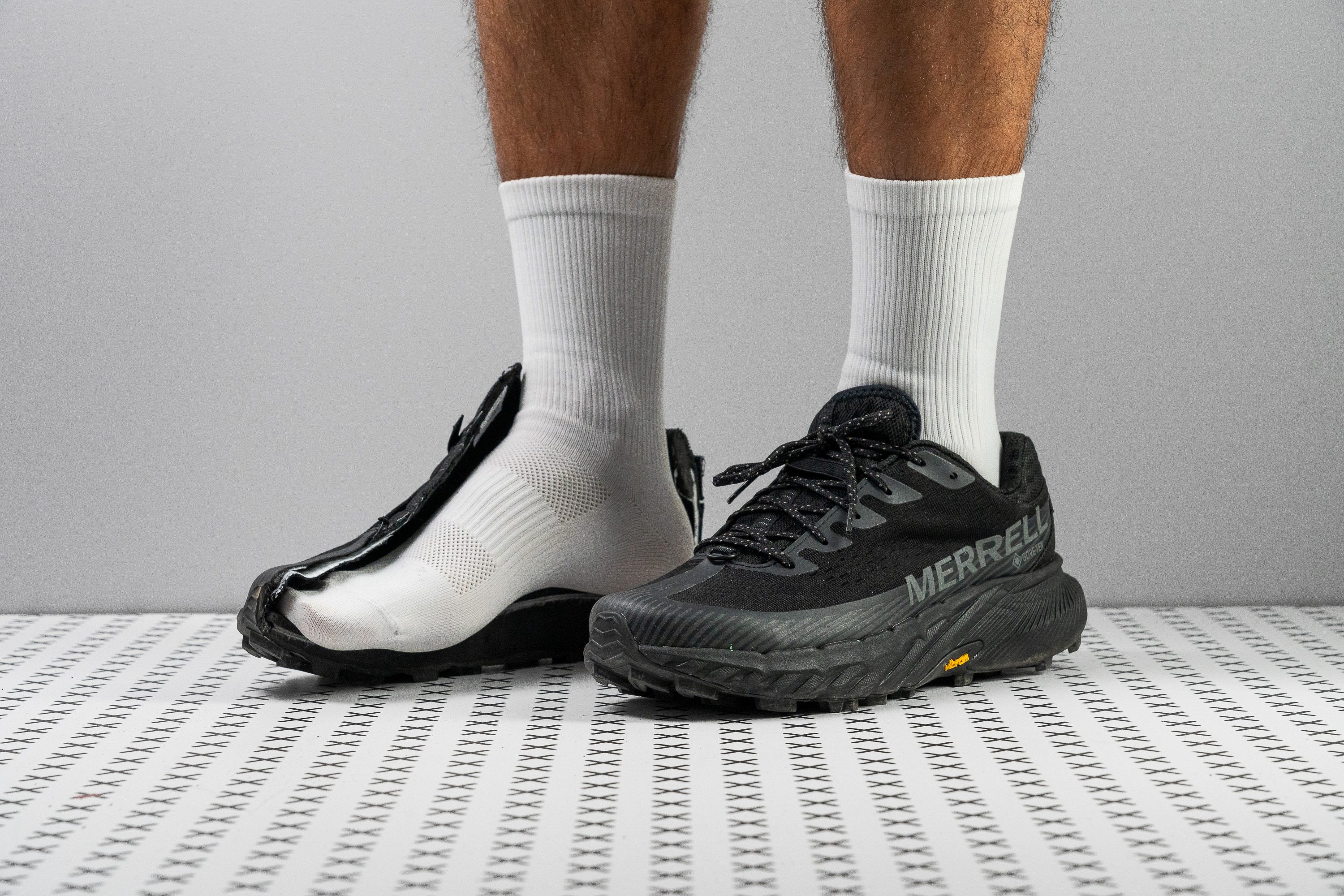













































What makes it the best?
Running in Merrell’s Agility Peak 5 GTX is being armoured with all-terrain, all-weather shoes. Our lab tests and runs show it’s all about protection. It provides dependable grip through its Vibram outsole and effective weatherproofing through its Gore-Tex membrane, making it our top waterproof trail shoe.
Unpacking the shoe in the lab, we discovered the outsole is made of Vibram Megagrip rubber lined with deep 4.4 mm lugs to ensure traction. They are chevron-shaped and strategically spaced to handle technical sections and muddy tracks with ease.
The upper is fully waterproof and feels very safe from outside elements. In the lab, we saw that neither light nor smoke could escape the Gore-Tex membrane, resulting in a 1/5 breathability score. The fully gusseted tongue keeps our feet dry even as we pass through river crossings.
Agility Peak 5 GTX can keep up with our whole-day adventures as it’s generously cushioned. Its stack rises above average, notably in the heel with a whopping 36.3 mm foam. Moreover, the platform features a rock plate underfoot to shield us from potential hazards.
Unfortunately, the toebox is narrow, and this model has no wide options available. Therefore, we can’t recommend it to runners with broad feet.
Pros
- True waterproof protection
- Grippy, trail-ready Vibram outsole
- Perfect for cold, wet climates
- Can handle some challenging conditions
- Stable yet cushioned heel
- Improved for hiking and walking
- Well-designed outsole lugs
- Great build quality
- Keeps feet warm
- Rock plate
Cons
- Narrow toebox
- Heel padding durability concerns
- No reflective elements
- Drop differs too much from stated
Waterproof running shoes with the best traction
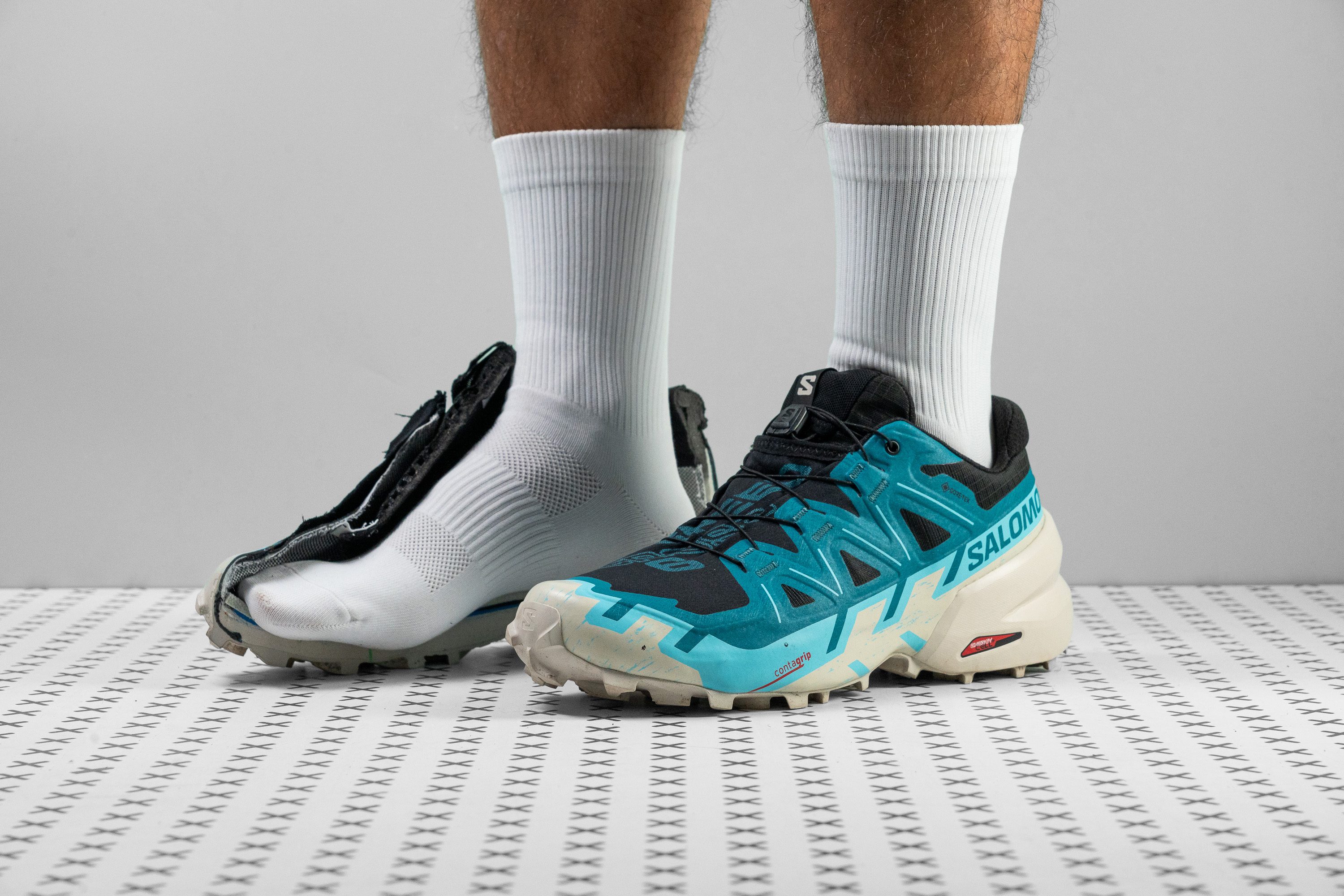
















































What makes it the best?
We found the waterproof running shoe that’s best equipped with grip after intensive lab tests and extensive runs, and it’s no other than Salomon Speedcross 6 GTX. Its remarkable impermeability allows us to encounter streams worry-free. Meanwhile, its supportive platform and remarkable traction ensure our control and safety on diverse terrains.
Even as we speed through corners, pass through wet rocks, and run through inclined trails, we feel in control thanks to the shoe’s incredible traction and deep 5.0 mm lugs. Being 1.4 mm deeper than average, it has extra bite even on softer ground. They are chevron-shaped for enhanced control and cleverly spaced to shed debris effectively.
As if dipping our shoes in streams isn’t proof enough, we also performed lab tests to verify this GTX’s waterproofness. Its 1/5 score means it blocks everything out—fine particles, moisture, and even cold air! Our microscope reveals a very compact knit upper.
While the cushion is a stacked 37.0/25.8 mm, its firm nature leads to a stable ride. Our durometer confirms it’s 23.7% harder than the average, which leaves no room for bottoming out. Even in our manual assessment, we had a tough time twisting the shoe (5/5) which proves it’s almost impossible to roll our ankles.
Given its firm cushion, Speedcross may feel too harsh for long distances. Runners who seek a plusher feel should look elsewhere.
Pros
- Fully functional Gore-Tex membrane
- Ample cushioning for long adventures
- Excels in challenging, technical terrain
- Rapidly sheds mud
- Agile and tenacious grip on twisted trails
- Remarkable durability
- Ideal for heel strikers
Cons
- Completely lacks breathability
- Midsole could feel overly firm for some
- Exceptionally heavy
- Narrow, snug-fitting toebox
Waterproof running shoes with best durability
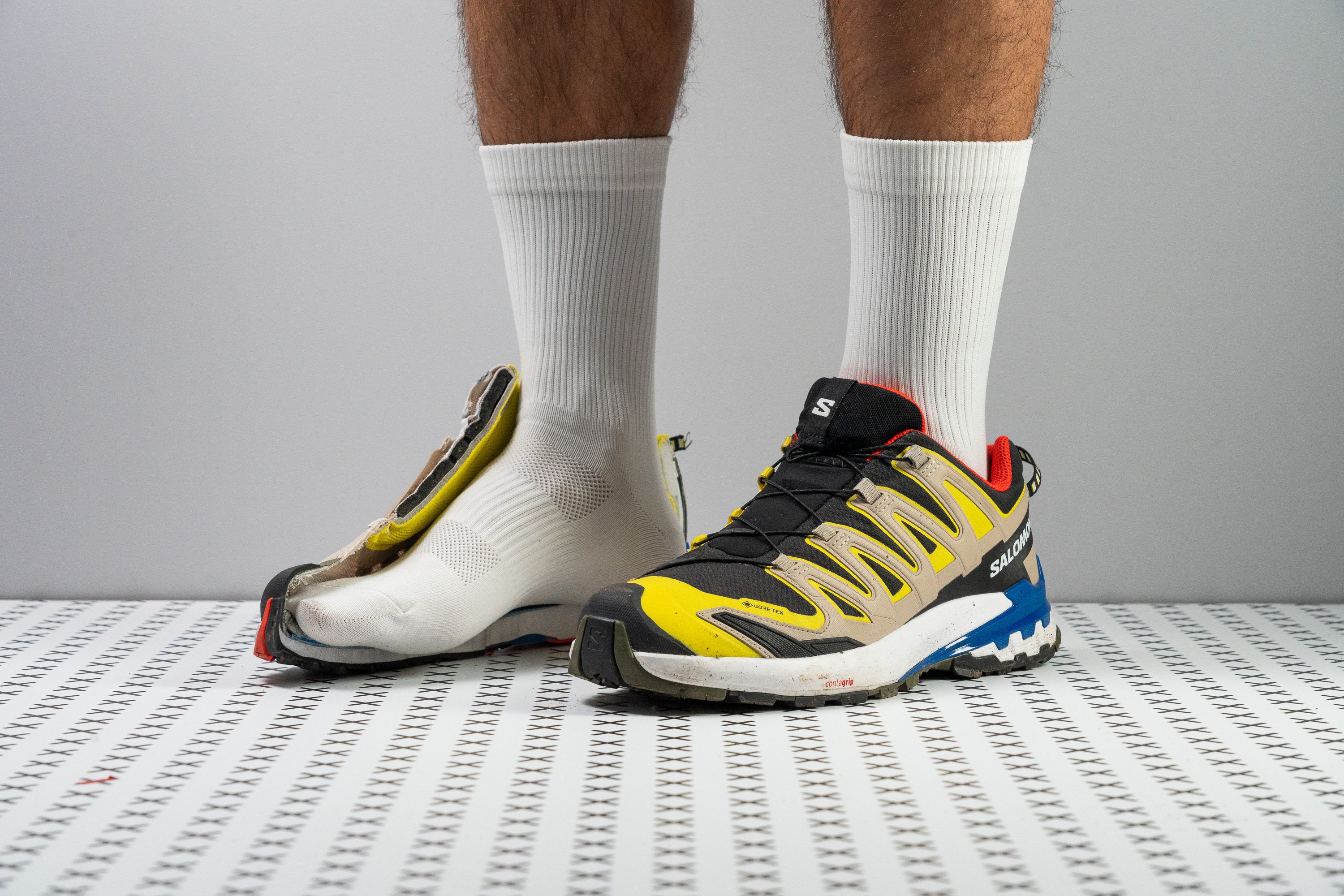













































What makes it the best?
From light runs to heavy backpacking on the trails, we surely felt stable and protected with Salomon's XA Pro 3D v9 GTX. It inspired confident and surefooted strides on wet encounters and uneven terrains as its watertight upper, firm midsole and grippy lugs supported us. Our lab proves it’s built like a tank, making it our top durable waterproof running shoe.
The first area we analysed is its Gore-Tex-wrapped upper, proving its impermeability when it scored a low 1/5 in our breathability test. Not a single drop of water entered as we traversed through below-the-ankle waters and rain. It also has a toe bumper that shields us from unexpected rocks and roots.
The next supportive layers are the midsole and 3D chassis which give a firm and stable ride. Our durometer confirms the cushion is 23.6% firmer than average, which means it won't bottom out. We also found the midsole difficult to twist, meaning it won’t easily give in to our excessive lateral movements.
Lastly, the Contagrip outsole has 2.8-mm sticky lugs to enhance traction on mixed terrains. Even after extensive testing on harsh paths, we felt reassured of its longevity since the rubber didn’t show signs of premature wear.
Unfortunately, this shoe is heavy at 12.7 oz (359g). Those who prefer lighter shoes should look elsewhere.
Pros
- Incredibly protective
- Extremely stable and supportive
- Watertight Gore-Tex upper
- Flexible and forgiving on the foot
- Makes a great hiking companion
- Effectively dampens landings
- Generously padded from heel to tongue
- No lace bite whatsoever
- Durable, high-quality construction
- Simple yet snazzy design
- Simple yet snazzy design
Cons
- Could be lighter
- Rather firm cushioning
- Upper needs breaking in
- Lacks the agility for technical trails
2 things to look for in waterproof running shoes
Wet weather means you must have: a) waterproof upper and b) superb grip for wet surfaces. Now we dig deep into both of them! And cover all the necessary details.
How to recognise a waterproof upper
You can recognise running shoes that are waterproof by looking for the name of the waterproof membrane. The most famous one is Gore-Tex (GTX). However, many brands develop their own trademarked waterproof membranes but you don’t have to know all the names. When a shoe is waterproof, a brand does everything to promote that feature. Some include waterproof or WP in the shoe name.
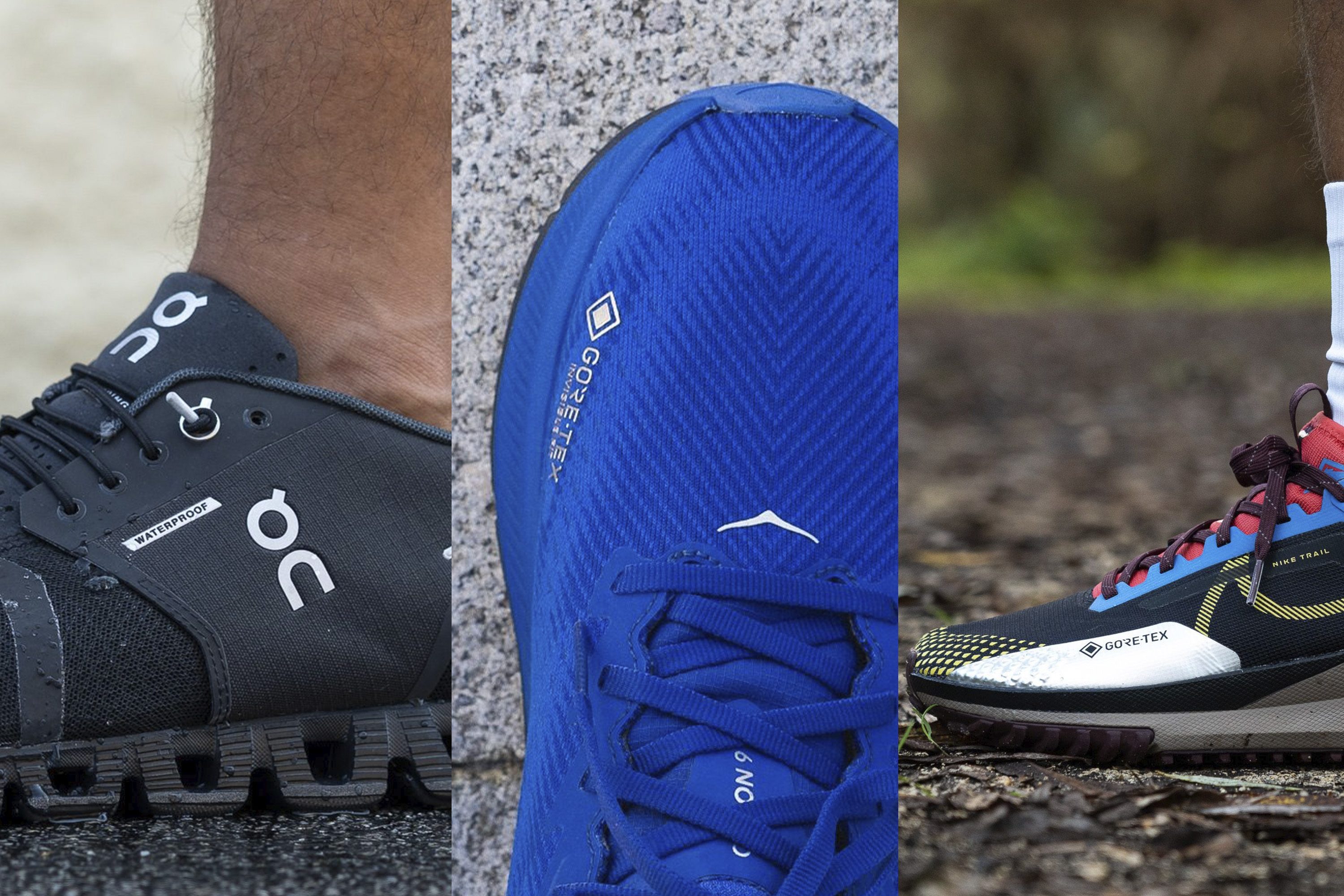
Also, when we examine the uppers under the microscope, it’s easy to notice that the waterproof ones are more tightly packed and woven. The non-waterproof ones have ventilation holes or loose threads which makes them more breathable.
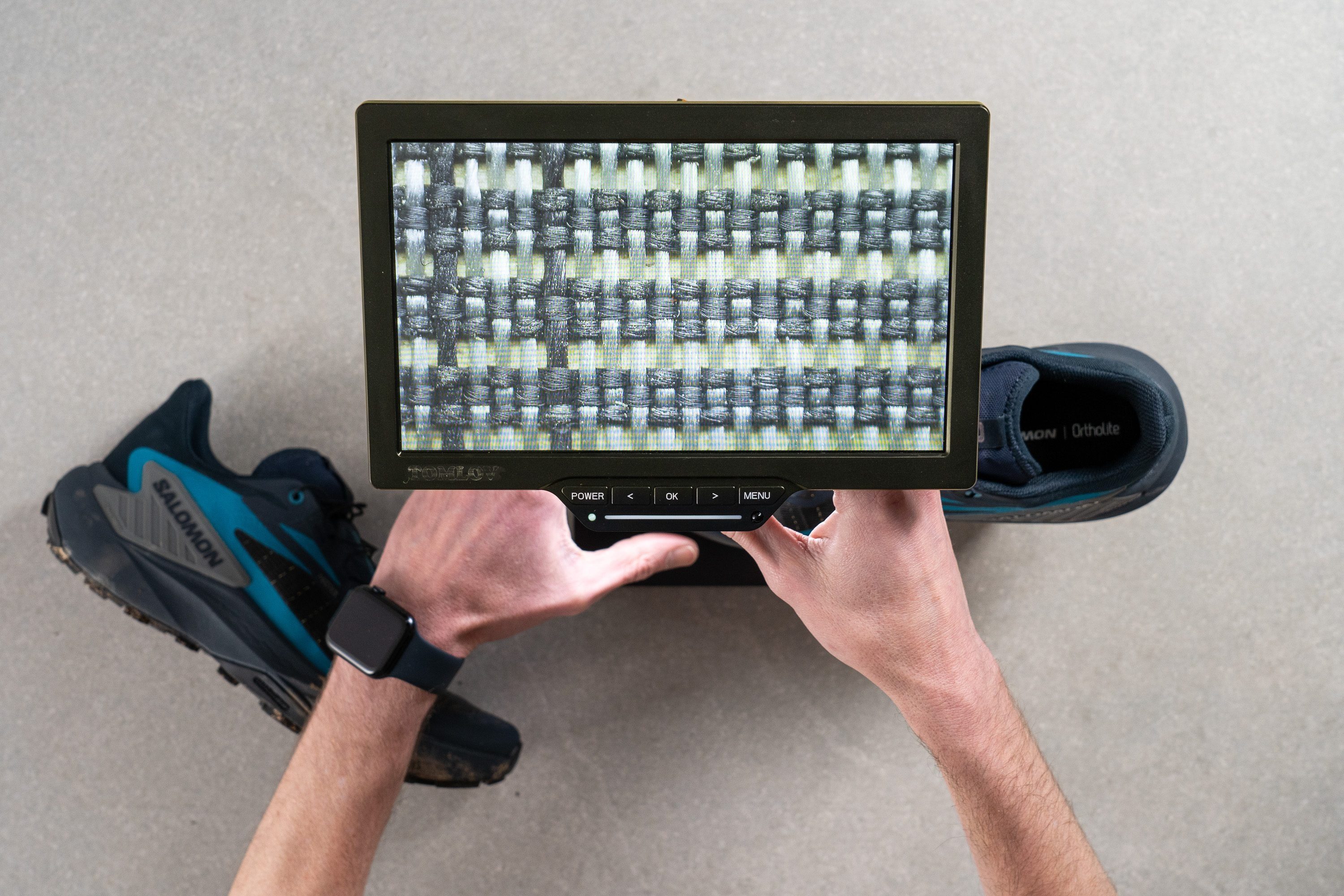
If you were to look on the inside, often you’ll be able to see the a lining of different colour. That lining, under the upper, is the waterproof membrane.
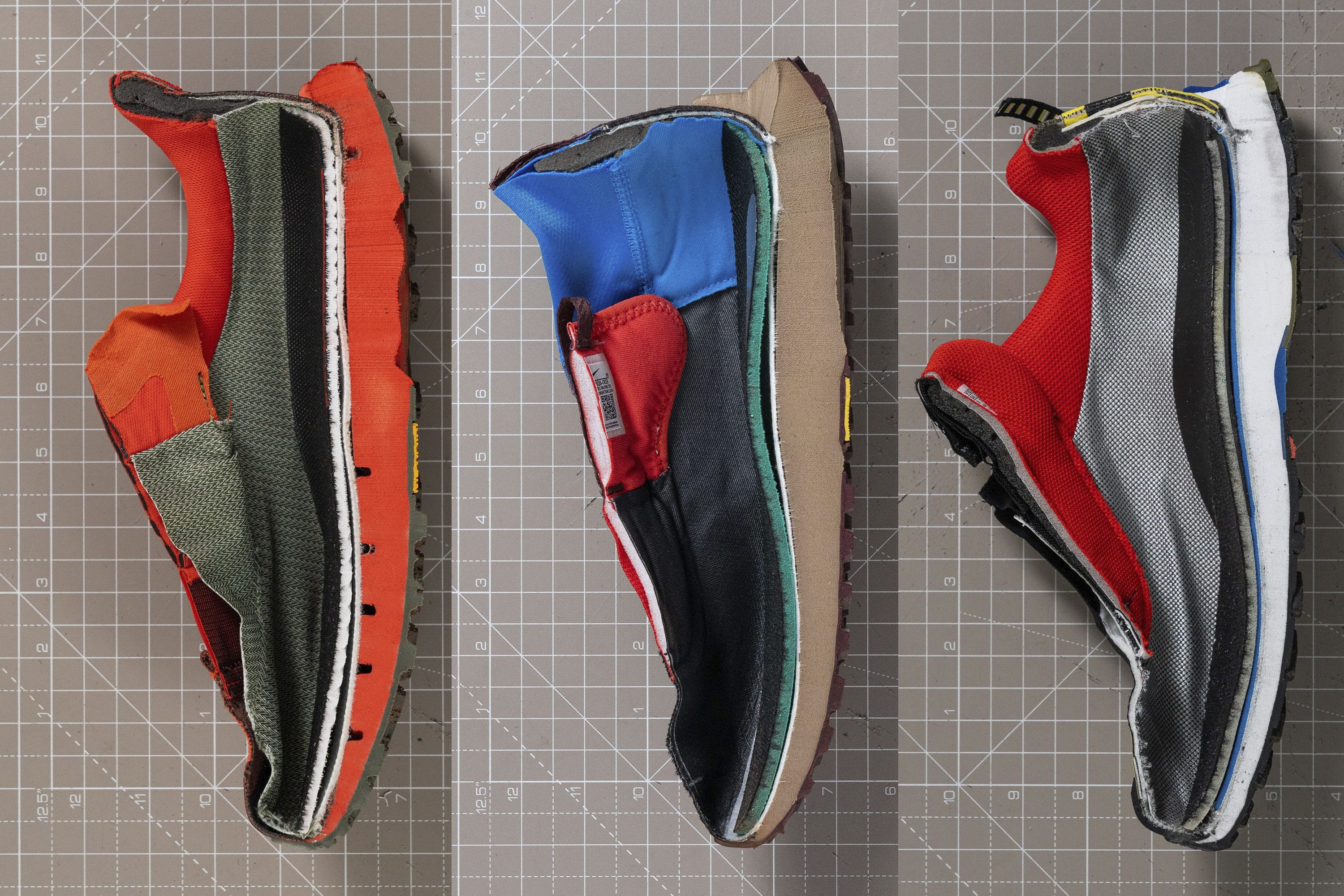
How much rain or snow can a waterproof upper withstand?
This is measured by the hydrostatic head in millimetres. The hydrostatic head is measured by filling a 1’’ x 1’’ tube with water and putting it over a piece of fabric. The number of millimetres of water that the tube can take before water begins to leak through the material is the hydrostatic head. The lower the number in mm, the less waterproof the fabric.

Knowing this, it’s on you to decide how waterproof the membrane should be depending on the weather conditions on your runs. Look at the table for reference:
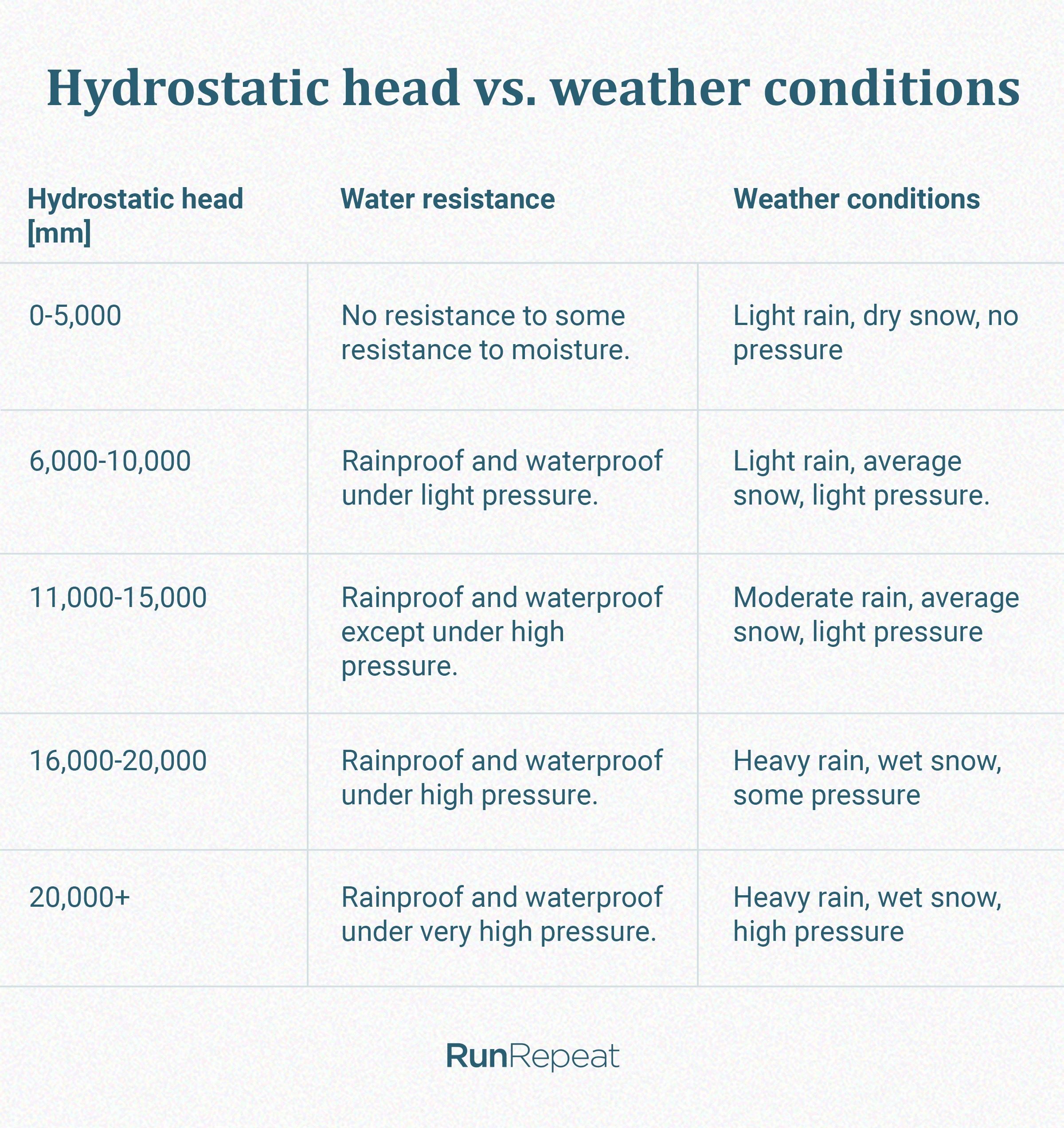
This applies to all waterproof materials, so you can use the table if you’re looking for waterproof trousers, jackets (usually hard shell), backpacks, and so on.
Different levels of water resistance in running shoes
Usually, if you want a waterproof runner, you want it. However, if you were just to learn how not-breathable they are, and usually expensive, maybe you would decide that you don’t have to get a waterproof shoe. Or, maybe you can deal with less water resistance.
If that’s the case, consider water-resistant or water-repellent running shoes.
| Water-resistant | Water-repellent | Waterproof | |
| General characteristics | a tightly woven fabric that is naturally capable of resisting water upon contact | fabric treated with durable water-repellent (DWR) or hydrophobic chemicals | - fabric treated with DWR - have waterproofing membranes like Gore-Tex and OutDry - have seam-sealed construction for extra protection |
| Water protection level | low water protection | moderate water protection | high water protection |
| Water pressure resistance | 0-5000 mm (no pressure or moisture) | 6000-10000 mm (light pressure) | 10000-20000 mm (high to very high pressure) |
| Weather conditions best used in | light rain shower and dry snow | light rain and average snow | moderate to heavy rain and average to wet snow |
Finding the perfect grip in waterproof running shoes
There’s no perfect test for grip in dry and wet weather as it depends on many things, like runner’s foot strike, rubber placement (coverage) on the outsole, rubber hardness, thread design, lug depth and shape (if we’re talking about trail shoes), inclination, surface type, etc.
But, what usually stands is: softer rubber is stickier, while harder rubber is more protective and durable.

Pay attention to:
- Rubber coverage. The less exposed midsole there is, the better the grip! The exposed midsole will just slide.
- Thread pattern. Look for grooves and channels, just like you would in car tyres for wet weather. More water asks for more channels. Flat surfaces are a no.
- In trail shoes, deeper lugs bite better than the shallow lugs, especially into mud, slush, snow.
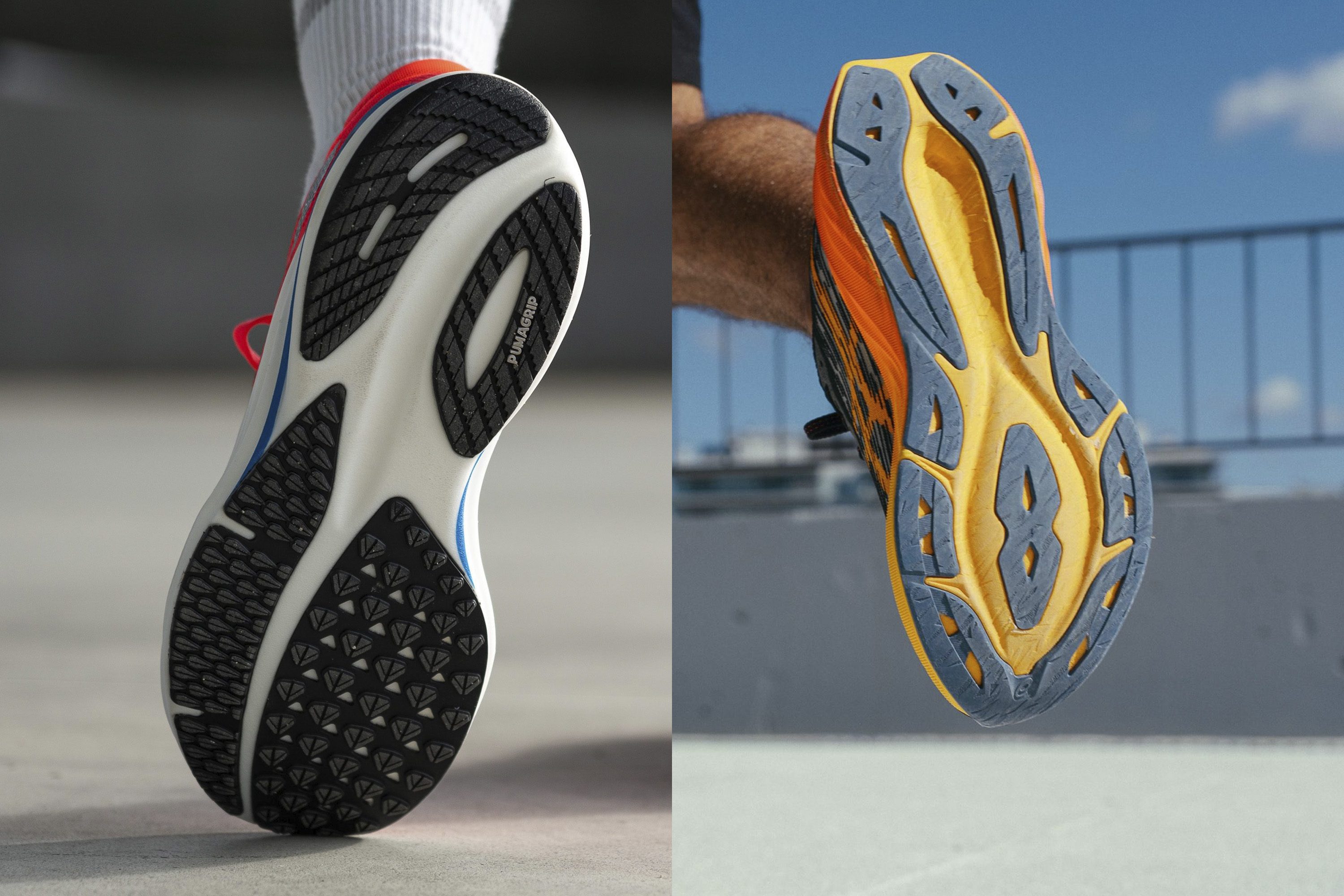
If the topic of outsoles peaks your interest, we wholeheartedly recommend reading our guide In-depth insights into running shoe outsoles (road & trail).
When it comes to softness, in our lab, we use a shore C durometer to measure how hard the outsole rubber is.

In the lab, we also use a Dremel to test the durability of the outsole. Once the damage is made, we use a tyre tread gauge to measure the depth of the dent with great precision.
Shallow dents mean the outsole is more durable than the one that got a deeper dent. Simply, it was more difficult for Dremel to make the damage.
We also measure the depth of the lugs (in trail shoes). Deeper lugs mean more grip.
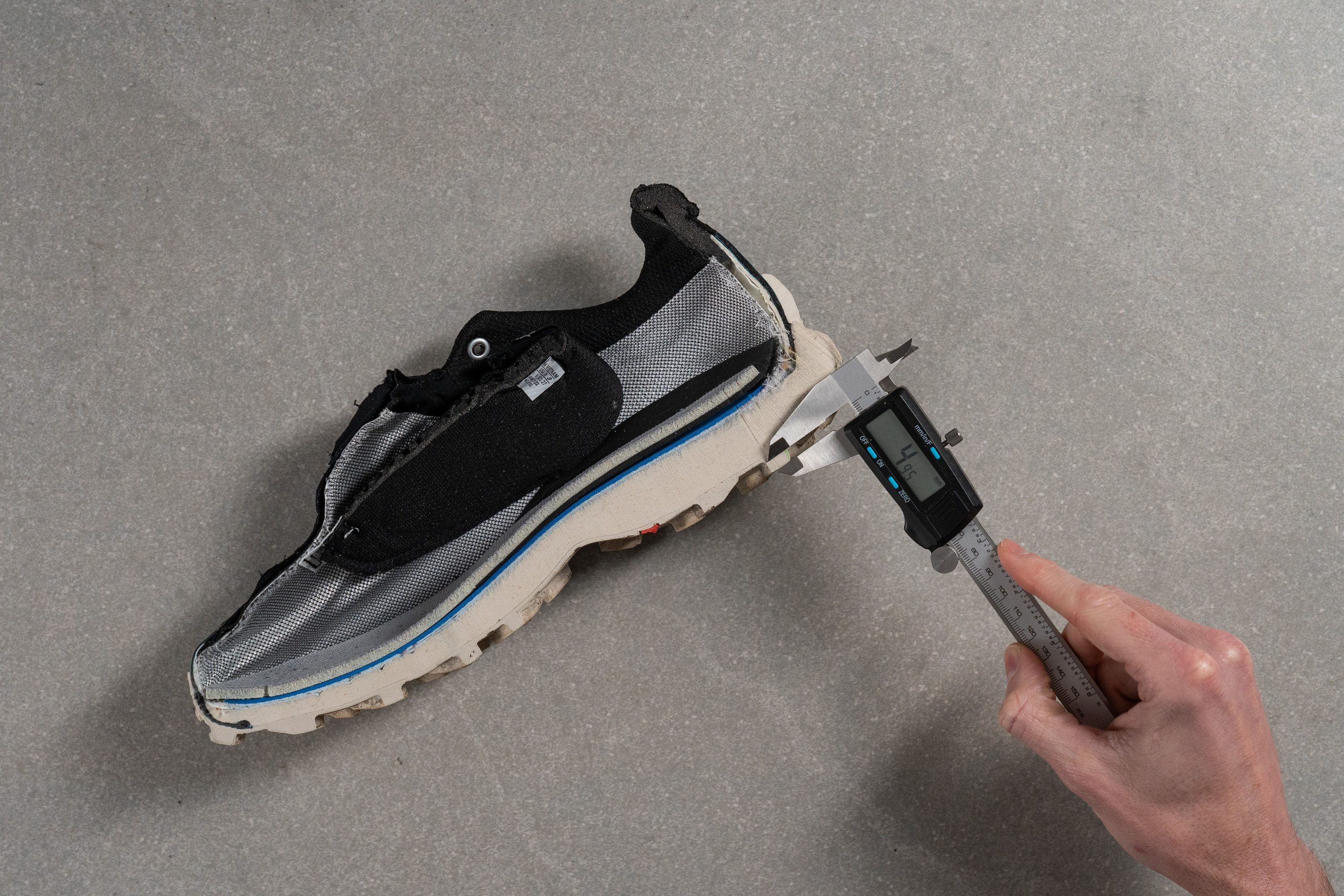
Waterproof running shoes are NOT breathable
While producers of waterproof membranes will claim that their membranes breathe, the fact is, they might but only to a certain degree. Compared to see-through uppers we find in perfect summer shoes or simply very ventilated mesh uppers, waterproof membranes turn out to be, well, not breathable.
We test breathability in our lab using a smoke machine. We pump the smoke into the shoe and watch where it comes out and at which pace. Based on this, we assess the breathability on a 1-5 scale, where 1 is the least breathable.
We also look at the uppers under the microscope to understand what’s happening in greater detail. When it comes to waterproof running shoes, it’s easy to understand why they are less breathable.
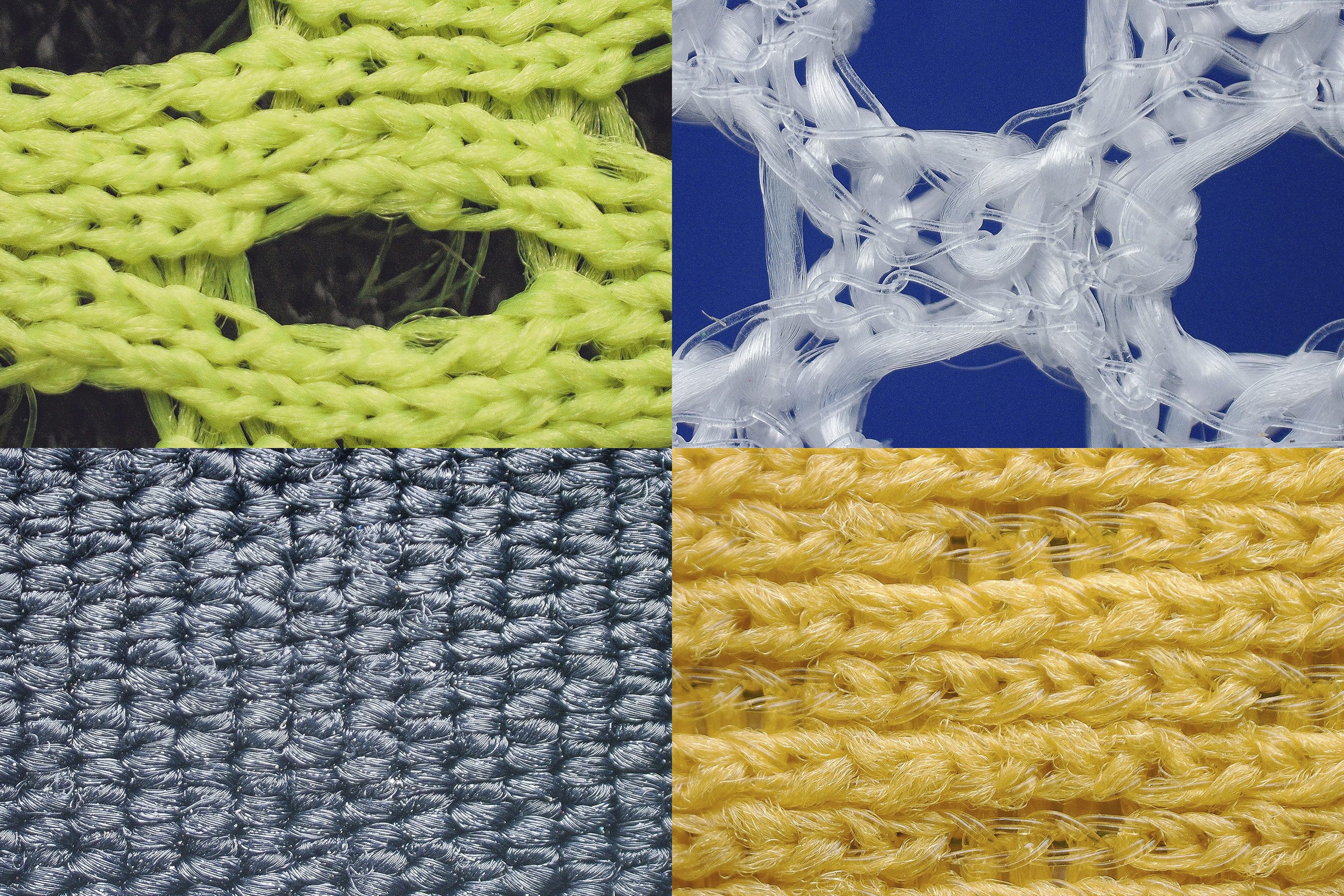
Next to the waterproof membrane, waterproof running shoes also usually feature a gusseted tongue, to prevent the water from coming inside below the eyelets or in case the tongue moves to the sides, so there’s even less chance of heat coming out in that area.
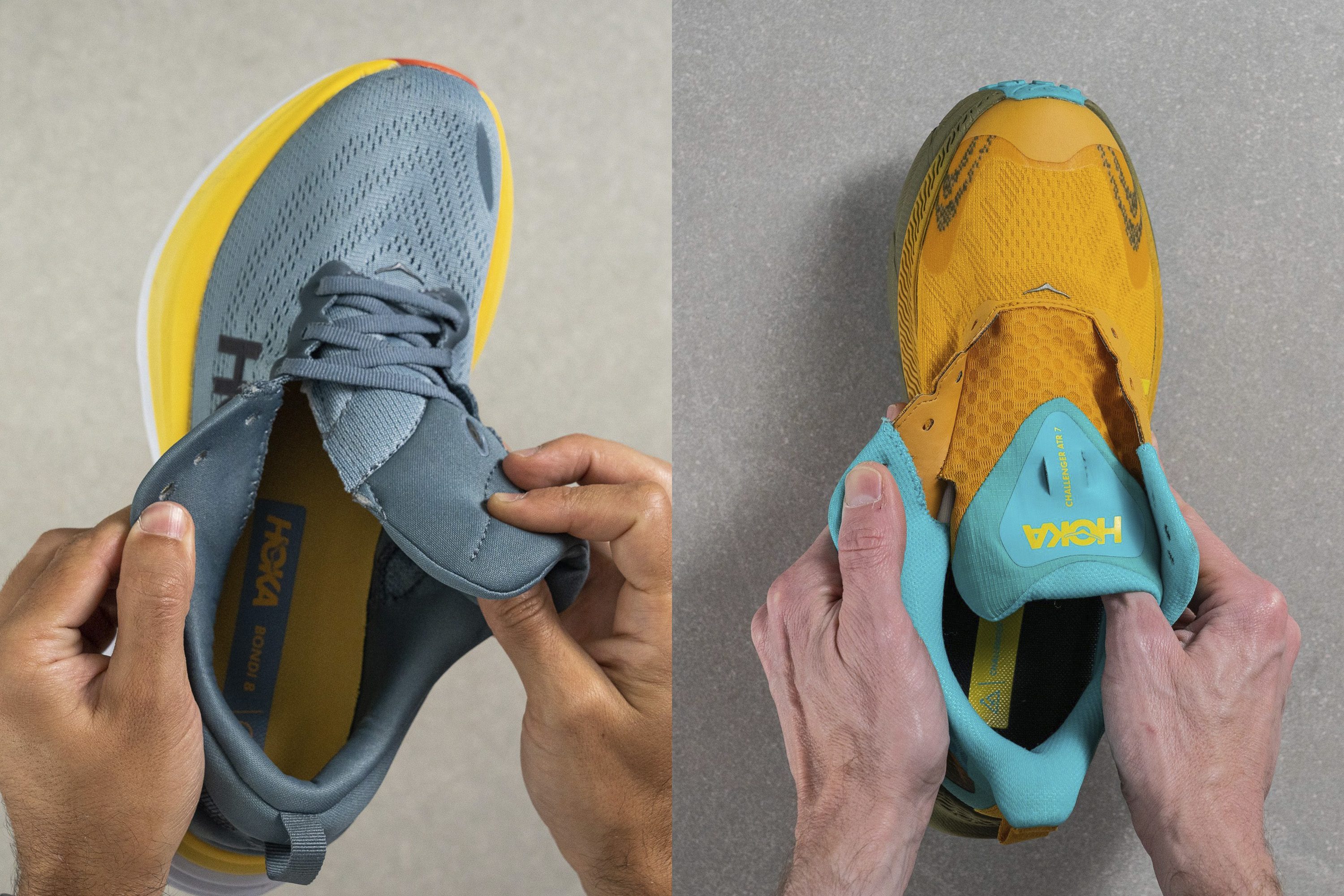
Also, it’s good to know that in the world of non-waterproof running shoes, it’s better to choose a mesh upper than a knit one. Mesh is more breathable and dries faster, while a knit upper will soak up rain and become heavy. To learn more about the upper materials and which one makes the best sense for your needs, please read Running shoe upper: how to choose the best one for your needs.
When not to get waterproof running shoes
Avoid these shoes when:
- You prioritise breathability and can’t stand the heat inside the shoes.
- There will only be a few rainy/snowy sections on your run. You might be better off without waterproof running shoes then. If the water gets inside your shoes on those short sections, it will stay there. However, in non-waterproof running shoes, if you just keep running, by the end of the run or race, your shoes might dry out due to your feet’s heat and the breathability of the upper.
- The water levels (be it slush, snow, or very wet tall grass) are simply too high. Then, you can get waterproof gaiters to prevent the water from getting inside of your shoes, OR you can get waterproof high-cut hiking shoes. Whichever the case, make sure your socks are made of high-quality materials for such occasions, like wool or bamboo.
Waterproof running shoes are expensive
These shoes cost more because waterproof membranes are not cheap. However, when you nail the fit and purpose, the investment pays off easily.

